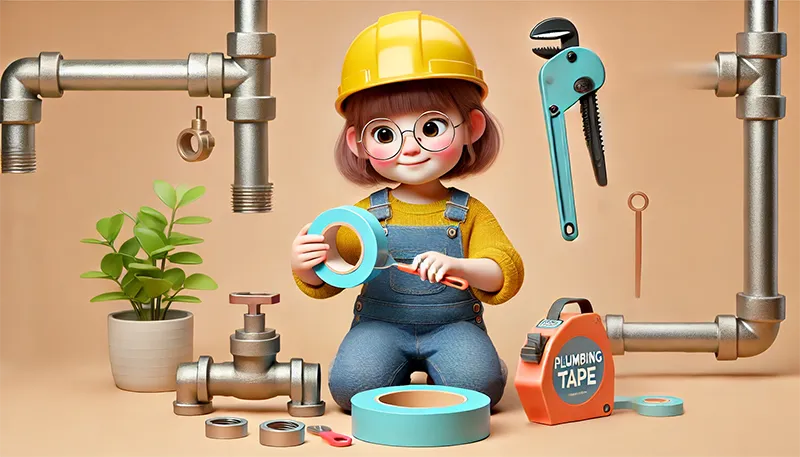Did you know that a simple roll of plumbing tape can solve some of the most common household plumbing problems?
Whether it’s a leaky faucet, a dripping showerhead, or a loose pipe joint, plumbing tape is an affordable and effective solution for quick repairs. Its versatility and ease of use make it an essential tool for any DIY enthusiast.
This guide will show you how to use plumbing tape to fix common issues, walk you through step-by-step instructions, and provide tips for achieving leak-free results.
With the right techniques and a little practice, you’ll be tackling plumbing problems like a pro.
What is Plumbing Tape and Why is It Essential?
Plumbing tape, also known as Teflon or PTFE tape, is a non-adhesive, flexible material designed to seal threaded connections.
It works by filling gaps between threads, creating a watertight or airtight seal that prevents leaks.
Benefits of Plumbing Tape:
- Affordable and easy to use.
- Prevents leaks in water, air, and gas systems.
- Reduces friction, making it easier to tighten fittings.
- Protects threads from corrosion.
Types of Plumbing Tape:
- White: Standard tape for general plumbing applications.
- Yellow: Gas-rated tape for natural gas and propane lines.
- Pink: Heavy-duty tape for high-pressure water systems.
- Green: Non-reactive tape for oxygen lines and medical gas systems.
- Gray: Designed for stainless steel pipes to prevent thread galling.
Choosing the right type of tape ensures effective sealing and long-lasting results for your repairs.
Learn more about Teflon Tape Colors: What Do They Mean?
Common Plumbing Problems You Can Fix with Plumbing Tape
Leaky Faucets
A dripping faucet is one of the most common plumbing issues. The cause is often a gap in the threads of the connection.
Fix: Wrap plumbing tape around the threads to create a watertight seal.
Steps:
- Unscrew the faucet.
- Clean the threads to remove debris or old tape.
- Wrap the tape clockwise around the threads 2-4 times.
- Reattach the faucet and tighten snugly.
Showerhead Drips
If water drips from your showerhead even when it’s turned off, the threads may not be sealed properly.
Fix: Wrap Teflon tape around the threads before screwing the showerhead back in place.
Loose Pipe Joints
Loose pipe joints can cause leaks or instability in your plumbing system.
Fix: Apply plumbing tape to the male threads of the pipe joint to tighten the connection and prevent leaks.
Gas Line Sealing
Gas lines require special care due to the risks of leaks and flammability.
Fix: Use yellow gas-rated tape to safely seal the threads of gas line connections. Always test for leaks after completing the repair.
Emergency Repairs
Plumbing tape is an excellent temporary solution for sudden leaks or loose fittings.
Fix: Apply plumbing tape to seal the connection until you can make a permanent repair.
Learn more about “5 Common Plumbing Problems Solved with Thread Seal Tape”
How to Use Plumbing Tape for DIY Repairs
- Prepare the Threads
Start by cleaning the threads to remove dirt, debris, or old tape. A clean surface ensures the tape adheres properly and creates an effective seal. - Wrap the Tape Clockwise
Always wrap the tape in the direction of the threads (clockwise). This prevents the tape from unraveling when you tighten the fitting. - Use the Right Number of Wraps
- For small pipes: 2-4 wraps are sufficient.
- For larger pipes or high-pressure systems: Use 4-6 wraps.
- Tighten the Connection
Screw the fitting into place and tighten it snugly. Avoid over-tightening, especially on plastic threads, to prevent damage.
Learn more about “How to Use Teflon Tape for Leak-Free Connections”
Tips for Successful Plumbing Tape Repairs
- Match the Tape to the Job
- White tape for water pipes.
- Yellow tape for gas lines.
- Pink tape for high-pressure water systems.
- Avoid Overwrapping
Using too much tape can make threading difficult and result in an uneven seal. Stick to the recommended number of wraps. - Check for Leaks
After completing the repair, run water or use a gas leak detector to ensure the connection is secure. - Replace Old Tape
Always remove old tape and apply fresh tape when reassembling fittings.
Mistakes to Avoid
- Using the Wrong Tape
- Example: Using white tape on gas lines instead of yellow tape. Always choose the correct tape for the application.
- Wrapping in the Wrong Direction
- Wrapping counterclockwise causes the tape to unravel during tightening.
- Failing to Clean Threads
- Dirt or old tape remnants can prevent proper sealing.
- Skipping Leak Tests
- Always test the repair to confirm the seal is secure and leak-free.
FAQs
-
Can I use plumbing tape on smooth pipes?
No, plumbing tape works only on threaded connections.
-
How long does plumbing tape last?
Properly applied tape can last as long as the connection remains sealed.
-
Can plumbing tape fix a cracked pipe?
No, plumbing tape is not designed for cracks. Use silicone tape or other sealing methods for such repairs.
-
Is plumbing tape reusable?
No, always use fresh tape when undoing and reassembling a connection.
-
What type of plumbing tape should I use for drinking water lines?
White or pink Teflon tape is suitable for potable water systems.
Plumbing tape is a versatile and essential tool for DIY repairs. With the ability to fix leaks, secure connections, and handle emergency repairs, it’s a must-have for any homeowner.
By choosing the right type of tape and applying it correctly, you can save time, money, and frustration.
Keep a variety of plumbing tapes on hand to handle different repair needs, and always follow proper techniques for leak-free results.
With a little practice, you’ll be prepared to tackle most plumbing challenges confidently and effectively.



